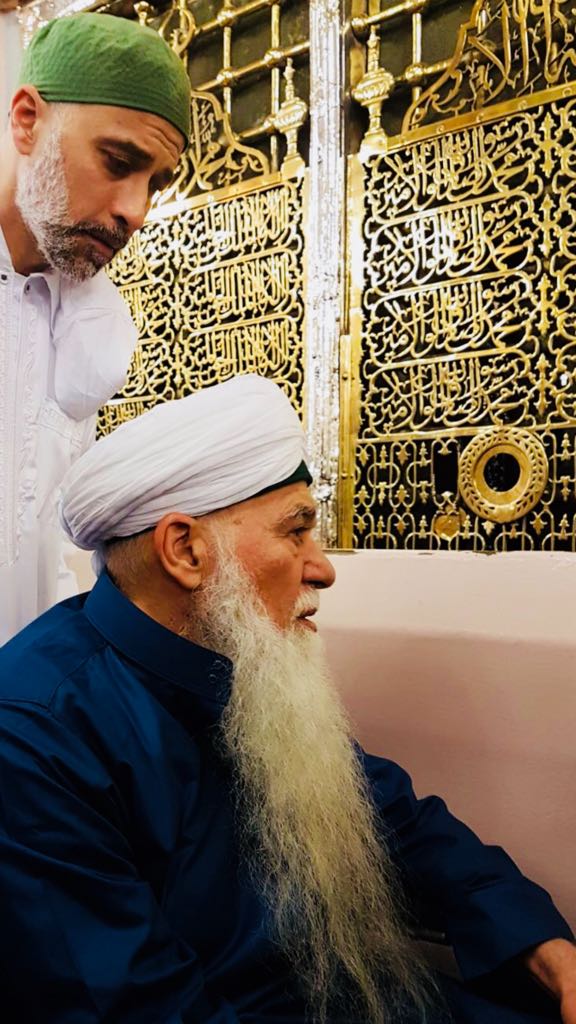
Position of Ahl as-Sunnah wal-Jama`at (al-`shaira) on Visiting the Blessed Grave of the Apostle of Allah (s)
Excerpt from the book Encyclopedia of Islamic Doctrine by Shaykh Muhammad Hisham Kabbani al-Ash`ari al-Naqshbandi on the belief and practice of Ahl al-Sunna wal-Jama`at.
Hadith: “Man zara qabri wajabat lahu shafa`ati.” “Whoever visits my grave, it is incumbent upon me to intercede for him.” Narrated by al-Daraqutni, al-Dulabi, al-Bayhaqi, Khatib al-Baghdadi, al-`Uqayli, Ibn `Adiyy, Tabarani, and Ibn Khuzaymah. All through various chains going back to Musa ibn Hilal al-`Abdiyy from Ubayd Allah Ibn Umar, both from Nafi`, from Ibn `Umar.
– Dhahabi declared this chain hasan (fair) as narrated. – al-Sakhawi has confirmed him in the Maqasid al-hasana. – al-Subki declared it sahih according to Samhudi in Sa`adat al-Darayn 1:77.
This is one of the proof-texts adduced by the ‘ulama of Islam to derive the obligation or recommendation of visiting the Prophet’s grave and seeking him as “wasilat” (intermediary/means). See the chapter on visiting the Prophet’s grave in Nawawi’s book al-Adhkar and in Qadi Iyad’s book al-Shifa.
This is the text of Imam Nawawi in the Book of Pilgrimage which is part of his larger book Kitab al-Adhkar [Book of Invocations and Prayers], according to the original manuscript, published editions (cf. Dar al-fikr in Damascus p. 306), and Ibn ‘Allan’s commentary on the Adhkar:
“Concerning the Visit to the Grave [qabr] of the Prophet (s) and the Invocations Pertaining Thereto:
Know that it is incumbent upon every pilgrim [yanbaghi] to go and visit the Prophet, whether this visit is on his way or not. Indeed, the visit of the Prophet (s) is among the most important of the acts that draw one near to God [qurubat] and of the most gainful of errands and of the most excellent of quests. Once one turns his steps to visit the Prophet (s), let him invoke abundant blessings on him while on the way. As soon as his sight reaches the trees of Madina [he invokes even more blessings]…”
[from a booklet by Hassan ibn Ali al-Saqqaf al-Husayni al-Shafi’i entitled: “al-Ighatha bi adillat al-istighatha” [Help With the Proof-Texts of Seeking Help] (Amman: Maktabat al-Imam Nawawi, 1410/1990) p. 17.)]
Nawawi relates this story of al-`Utbiyy in his book al-Adhkaar:
“Al-`Utbiyy said:
“As I was sitting by the grave of the Prophet (s), a Beduin Arab came and said: Peace be upon you, O Messenger of God! I have heard God saying: If they had only, when they were unjust to themselves, come unto thee and asked Allah’s forgiveness, and the Messenger had asked forgiveness for them, they would have found Allah indeed Oft-returning, Most Merciful, (4:64), so I have come to you asking forgiveness (of God) for my sin, seeking your intercession with my Lord [mustashfi`an bika ila rabbi]. “Then he began to recite (poetry):
‘O best of those whose bones are buried in the deep earth, And from whose fragrance the depth and the height have become sweet, May I be sacrificed for a grave which thou inhabit, And in which are found purity and bounty and munificence!.'”
- “Then he left, and I dozed and saw the Prophet (s) in my sleep. He said to me: ‘O `Utbiyy, run after the Beduin and give him glad tidings that God has forgiven him.'” And God Almighty knows best.”
[From al-Nawawi, Kitab al-Adhkar (Mecca: al-Maktaba al-Tijariyya, 1412/1992) p. 253-254.]
In the Sunni belief the Prophet is certainly alive in his grave. Ibn al- Qayyim uses the words ratibun matirun (“moist and fresh” i.e. as alive as can be) in his book al-Ruh. His grave is better than paradise. He is returning our greetings of peace and interceding for the Community, and his grave is more blessed than the Kaaba. Ibn `Aqeel al-Hanbali said, according to Ibn al-Qayyim in his Bada’i` al-fu’ad:
“Nothing is like the Hujra [Prophet’s room] by Allah! not the Kaaba, not the Throne and the Throne-Bearers, not the Sixth Paradise [Jannat `Aden], and not the Revolving Universes, for in that Hujra there is a BODY more precious in the balance than this world and the next.”
All Ahl as-Sunnah scholars considered it is sunnah to visit Rasulullah’s (s) grave. Some scholars even say it is wajib. The amir in the time of Imam Malik asked him, “when visiting Rasulullah, should one face the qiblah when addressing prayers on his behalf or should one face away from qiblah and towards the Prophet himself?” Imam Malik replied, “You must face the Prophet (s). If not for him you would not have known about the Ka’aba.”
In his book Musnad, Imam Abu Hanifa wrote this hadith: “Abdullah ibn ‘Umar (r) said, ‘It is sunnah to turn towards the Prophet’s (s) grave, one’s back being towards the qiblah.'” This indicates not only that it is sunnah to visit the grave of the Prophet (s) but it is also sunnah to turn’s one face towards his holy face.
Narrated Abu Hurayrah (r): The Prophet (s) said: Do not make your houses graves, and do not make my grave a place of festivity. But invoke blessings on me, for your blessings reach me wherever you may be. [Abu Dawud 10: 2037]
This hadith clearly indicates the acceptability of visiting the grave, the Prophetic stipulation being that it not be made a place of festivity. If the Prophet (s) had wished to prohibit the visit, he would have done so.
Furthermore, explaining that he is alive in his grave, responding to the greetings of those who greet him from near or far, is the hadith in Abu Dawud, narrated Abu Hurayrah (r): The Prophet (s) said: If any one of you greets me, Allah returns my soul to me and I respond to the greeting. [Abu Dawud, 10: 2036]
Finally, visiting the grave of the Prophet (s) falls under the general permission and recommendation to visit graves of the Companions and martyrs, which is Sunnah of the Prophet (s).
As narrated in a hadith in Abu Dawud, Rabi’ah ibn al-Hudayr said: I did not hear Talhah ibn Ubaydullah narrating any tradition from the Apostle of Allah (s) except one tradition. I (Rabi’ah ibn Abu Abdur Rahman) asked: “What is that?” He said: “We went out along with the Apostle of Allah (s) who was going to visit the graves of the martyrs. When we ascended Harrah Waqim, and then descended from it, we found there some graves at the turning of the valley. We asked: ‘Apostle of Allah, are these the graves of our brethren?’ He replied: ‘Graves of our companions.’ When we came to the graves of martyrs, he said: ‘These are the graves of our brethren.'” [Sunan Abu Dawud: 10: 2038.]
It is clear from the above, that not only did the Prophet (s) visit graves of his Companions, he made a special effort to do so and was accompanied by his Companions.”
History of the Blessed Grave of the Holy Prophet (s)
The Prophet (s) was buried in `A’isha’s room where he died, which in his time, was out of the Masjid.
1. Umar (r) first enlarged the mosque so that it was now possible to pray in the space falling behind the Noble Grave as well as “on the other side” as you put it, which was from the Rawda (space between Hujra and Minbar) to the Khawkha (Abu Bakr’s door). The Grave was inside but on the edge.
2. Uthman (r) then enlarged it further so that it was now possible to pray in the space falling immediately in front of the Noble Grave. Furthermore he moved the Prophet’s mihrab to the new wall but in the same central position. Grave inside but on the edge.
3. al-Walid enlarged it further, so that the Noble Grave now was no longer on the edge but was within a new wall opposite the Khawkha wall.
The Sahaba did not call into question the fact of the Prophet’s Mosque being the site of his grave, during their time, nor did the Tabi’een. The last Sahabi, may Allah be well pleased with them all, Abu al-Tufayl `Amir ibn Wathilat al-Laythiyy, died in the year 100 according to the authentic reports.” [al-Nabahani (1265-1350H) in al-anwar p. 440.]
`A’isha (r) said that SHE would have opened the access to the grave except that she wished to prevent people praying AT the grave. The Companions’s later enlargement, however, made it possible to pray TOWARDS the grave while inside the mosque, so at that time, `A’isha (r) changed the orientation of her room.
A hadith relates: “The best of my Community are those of the century [qarn] wherein I was sent, then those that came after them [this applies to al-Walid]” (Muslim 7:184). Among those included in those centuries, were the Amir al-Walid who was one of those “that came after the Companions.” He enlarged the mosque upon the recommendation of his brother-in-law Umar ibn Abdul Aziz. The latter’s standing in the Umma then and now is second only to the first four khalifas. and some scholars even consider him to be the fifth Rightly-Guided Caliph.
Bukhari in his book relates: God has cursed Christians and Jews as they took their prophet’s graves as mosque. “If such practices were not there”, `A’isha (r) said, “people would bring out their prophet but I am afraid lest the grave is taken as mosque.”
Muslim in his book “Sahih” quotes the Prophet (s) as saying: “Those who lived before you were taking their prophets’ and pious persons graves as mosques. Be aware not to take graves as mosques. I strictly prohibit you from doing this.”
Ahmad quotes the Holy Prophet praying: “O God, Thou may not let my grave be an idol worshipped.”
The Hujra (room) of Prophet (s) since `A’isha’s (r) time was shut closed instead of being of open access.
Hadrat `A’isha (r) said the above before the mosque was enlarged. When it was enlarged she made her room [i.e. Prophet’s room] triangular-shaped so that no-one could pray towards the grave while facing the qibla, specifically heeding the warning in the hadiths. Thus she allowed the inclusion of the Hujrat-is-sa’adah within the mosque, by preventing it from being opened and being made part of the mosque.
In sum:
1. `A’isha (r) blocked access to the grave so that no-one might pray at the grave-site, heeding the warnings of the Prophet (s).
2. The Companions’ enlargement made it physically possible to face the qibla and the grave at one and the same time while inside the mosque. However:
3. `A’isha (r) re-oriented her room and eliminated any confusion so that it might not be feasible to pray while facing the grave.
Blessings and greetings of peace upon the Best of Creation



